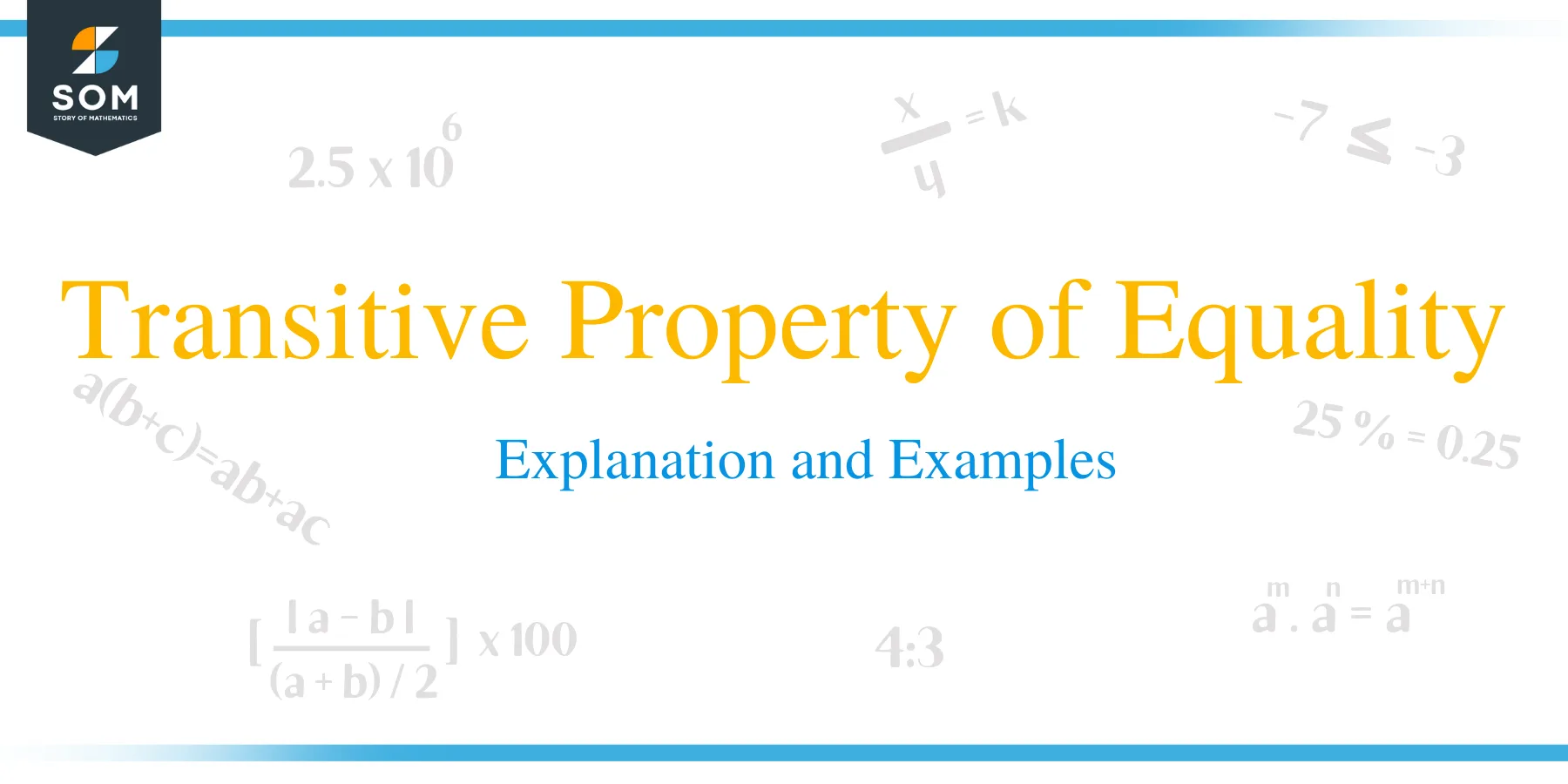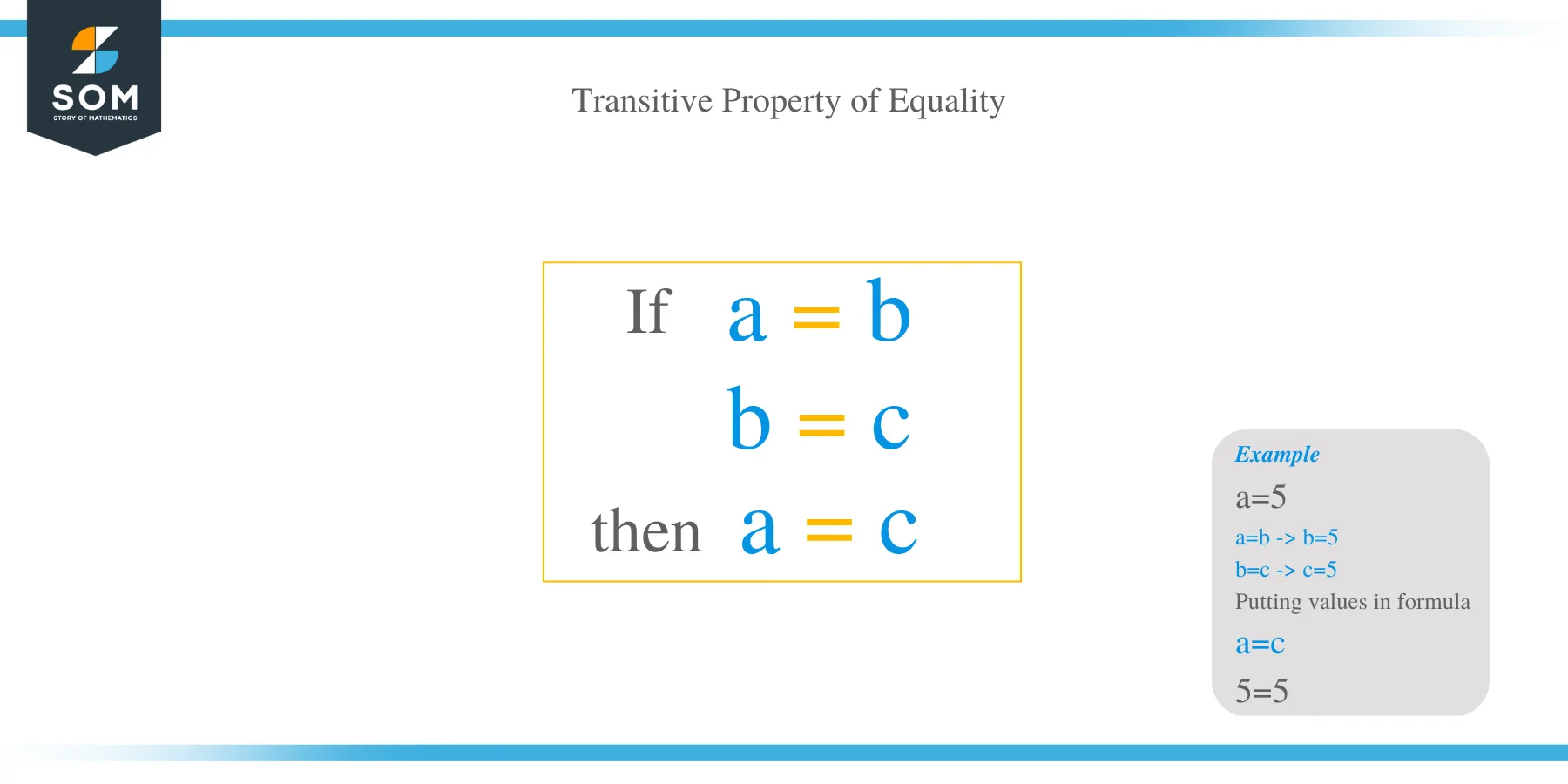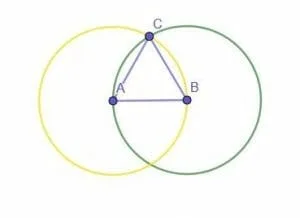- Home
- >
- Transitive Property of Equality – Explanation and Examples
JUMP TO TOPIC
Transitive Property of Equality – Explanation and Examples
 The transitive property of equality states that two things which are both equal to a third thing are equal to each other.
The transitive property of equality states that two things which are both equal to a third thing are equal to each other.
It establishes a relationship between multiple equal quantities and has important applications in arithmetic, logic, and algebra.
Although it can be proved using the substitution property of equality and the reflexive property of equality, it is usually treated as axiomatic. That is, it is not proved to be true but assumed to be true.
Before reading this section, make sure to review properties of equality.
This section covers:
- What Is Transitive Property of Equality?
- Transitive Property of Equality Definition
- Is the Transitive Property of Equality an Axiom?
- Example of Transitive Property of Equality
What Is the Transitive Property of Equality?
The transitive property of equality describes the relationship between two quantities that are both equal to a third quantity. These two quantities will also be equal.
Like other axioms, this may seem intuitive and stating it may seem unnecessary. Stating it, however, ensures that arithmetic is rigorous. That is, it holds up to logical scrutiny.
Giving the property a name and formal definition also makes it easier to reference in proofs.
Euclid did just this when he described the transitive property at the very beginning of Book 1 of the Elements. He called it “common notion 1,” and it formed the basis of the logical steps in his works.
Transitive Property of Equality Definition
In Elements, Euclid defines the transitive property of equality when he defines common notion 1. His definitions says, “things which are equal to the same thing are also equal to each other.”
That is, the transitive property of equality asserts that two things both equal to a third equal each other.
Arithmetically, this is:
If $a=b$ and $b=c$, then $a=c$ too.
The transitive property of equality is true for all real numbers.

Is the Transitive Property of Equality an Axiom?
The transitive property of equality is also one of the Peano axioms. This is a set of axioms, or facts taken for granted in proofs, set forth by mathematician Giuseppe Peano in the 1800s. His axioms only applied to natural numbers, though the many of the principles have been extended.
Others had set out lists of axioms before Peano. For example, Euclid’s common notions in his Elements can be seen as axioms since they are not proved. Peano’s were notable because he intended his list to be an aid in making arithmetic more rigorous as formal mathematical logic was taking off.
Two of the axioms, namely, the transitive property of equality and the symmetric property of equality, however, can be deduced from other axioms. Since they have been considered foundational and used historically. However, Peano still listed them. Others usually do the same and will them as axioms in their own right.
The deduction of the transitive property from the substitution property of equality is shown below in example 3. Practice problem 3 requires deducing the transitive property from the reflexive property of equality.
Example of Transitive Property of Equality
A famous example of the transitive property of equality is in the proof of the common construction of an equilateral triangle using a ruler and compass. The proof aims to show that the object constructed is indeed an equilateral triangle.
The construction begins with a given line segment, AB. Then, two circles are constructed. One has center A and radius AB, while the other has center B and radius BA.
The intersection of the two circles is marked C. Then, connecting A to C and B to C creates the equilateral triangle ABC.

Why?
AB is the radius of the circle with center A and radius AB (the yellow circle). AC is also a radius of this circle and all radii are equal, so AB=AC.
AB is also the radius of the circle with center B and radius BA because AB=BA by the reflexive property of addition. Since BC is also a radius of this circle, AB=BC.
Since AB=BC and AB=AC, the transitive property of equality states that AC=BC. Therefore, all three lines are equal to each other, making ABC an equilateral triangle.
Examples
This section covers common problems using the transitive property of equality and their step-by-step solutions.
Example 1
Suppose $a=b, b=c$, and $c=d$. Which of the following are equivalent?
- $a$ and $c$
- $b$ and $d$
- $a$ and $d$
Solution
All three of these pairs are equal, but we must use the first equation to prove the last one.
Since $a=b$ and $b=c, a=c$ by the transitive property of equality.
Likewise, since $b=c$ and $c=d$, the transitive property of equality states that $b=d$.
Now, we know that $a=c$ from the first bullet point. It is also given that $c=d$. Therefore, applying the transitive property of equality, $a=d$.
Example 2
Three sisters compare their heights.
Miranda is the same height as Shaylee.
Shaylee is the same height as Tia.
How does Miranda’s height compare to Tia’s?
Solution
Let $m$ be Miranda’s height, $s$ be Shaylee’s height, and $t$ be Tia’s height.
The given statements tell us that $m=s$ and $s=t$.
Employing the transitive property of equality gives us $m=t$.
Therefore, Miranda’s height must also be equal to Tia’s height.
Example 3
Explain how to use the substitution property of equality to prove the transitive property of equality.
Solution
Recall that the transitive property of equality is usually listed as axiomatic. That is, most mathematical logic does not prove that the transitive property holds. Instead, it assumes this as basic fact.
The transitive property, however, can be deduced from be deduced from other properties of equality. Namely, the transitive property follows from the substitution property.
Recall that the transitive property of equality states that if $a=b$ and $b=c$, then $a=c$.
Let $a, b, c$ be real numbers such that $a=b$ and $b=c$.
Then the substitution property of equality states that, since $b=c$, $c$ may replace $b$ in any equation.
Therefore, $a=c$ by the substitution property.
But this proves the transitive property. QED.
Example 4
The transitive property of equality states that if $a, b,$ and $c$ are real numbers such that $a=b$ and $b=c$, then $a=c$. Does the inverse hold?
That is, if $a, b,$ and $c$ are real numbers such that $a\neq b$ and $b\neq c$, then $a\neq c$.
Solution
The inverse does not hold in this case.
Recall that in mathematics, a statement is only true if it always is true. It is false if it is false in even one case.
For this reason, the statement “all prime numbers are odd” is false. There is only one even prime number, 2, but that is enough to make the entire statement false.
To prove a statement is false, it is necessary to find just one counterexample.
In this case, it is required to find a three numbers $a, b,$ and $c$ such that $a=c$ but $a\neq b$ and $c\neq b$.
One possible counter example is if $a=1$, $b=0$, and $c=1$.
In this case, the transitive property of equality states that since $a=1$ and $c=1$, $a=c$.
But, $a\neq b$ and $c\neq b$. Therefore, the inverse of the transitive property of equality is not true.
Example 5
Let $w, x, y$ and $z$ be real numbers such that:
$3y-2w+2z=7z+2y$
and
$-4x+4w-3z=2z+6w-5x$
Use the transitive property to show that $x=y$.
Solution
This problem requires first solving for $x$ and $y$ using the addition and subtraction properties of equality.
If $3y-2w+2z=7z+2y$, the subtraction property of equality states it is possible to subtract $2y$ from both sides.
$3y-2y-2w+2z=7z+2y-2y$
This simplifies to:
$y-2w+2z=7z$
Then, add $2w-2z$ to both sides. The addition property of equality says it is possible to do this and maintain the equality.
$y-2w+2z+2w-2z=7z+2w-2z$
This simplifies to:
$y=5z+2w$
Next, use the addition and subtraction properties of equality and simplification to solve for $x$.
$-4x+4w-3z=2z+6w-5x$
First, use the addition property of equality to add 5x to both sides.
$-4x+5x+4w-3z=2z+6w-5x+5x$
This simplifies to:
$x+4w-3z=2z+6w$
Then, subtract 4w-3z from both sides. The subtraction property of equality states that this will not affect the equality.
$x+4w-3z-(4w-3z)=2z+6w-(4w-3z)$
This becomes:
$x+4w-3z-4w+3z=2z+6w-4w+3z$
which simplifies to:
$x=5z+2w$
Since $y$ is equal to $5z+2w$ and $x$ is also equal to $5z+2w$, the transitive property of equality asserts that $x=y$.
Images/mathematical drawings are created with GeoGebra.
